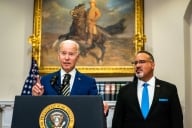You have /5 articles left.
Sign up for a free account or log in.
Like officials of many public flagship universities, administrators at the University of Minnesota have grown increasingly concerned about keeping the institution affordable for students from low-income families. As tuition has shot up by 75 percent since 2000 (necessitated, university officials say, by sizable cuts in financial support from the state), "we've made it a priority to try to cushion the impact of those increases on low-income students," said Robert Bruininks, the university's president.
Last year, Minnesota joined the growing ranks of elite private and flagship public universities altering their financial aid policies to ease the way for lower-income students. It unveiled the Founders Opportunity Program, which committed to providing enough university grant aid (on top of Pell Grants and other private scholarships) to meet the full tuition and fees, for four years, for incoming freshmen from families with annual incomes under $50,000.
Friday, the university's Board of Regents expanded the program to cover students who transfer in to the institution as well.
About 25 to 30 percent of students at Minnesota enter as juniors after attending a community college or other institution, and as is the case at many colleges, the institution has traditionally had little financial aid to offer them, having expended most of its available funds on those who start as freshmen. "They're really out of the game" in many cases, says Bruininks.
Beginning next year, under the expanded program, any Pell-eligible student -- whether he or she begins as a freshman or transfers in as a junior -- will have all tuition and fees met through a combination of Pell funds, academic scholarships or university need-based grants. The university will also fully match a student's Pell Grant, which could give the lowest income students some additional funds for housing or other costs. "This puts transfer students on an equal footing with other students" at the university, Bruininks says.
Minnesota officials estimate that the program will provide about $22 million in new aid to about 4,500 students. A financial aid fund raising drive that the university began in 2004, which matches gifts of $25,000 dollar for dollar, has raised about $107 million thus far.









